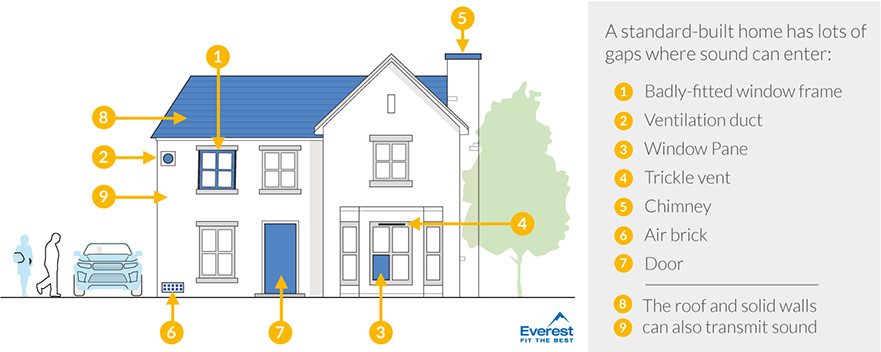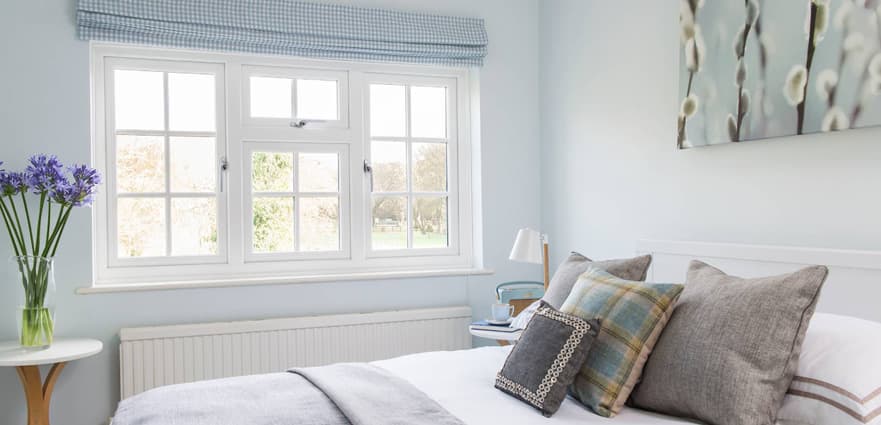Where Is the Sound Coming From?
If you want to 'soundproof' a room then you first need to figure out where the noise is coming from and what type of noise it is.
We use the term 'soundproof' in this article, but we only refer to the possibility of noise reduction.
There are two main ways that noise travels:
- Through the air
- Through other objects
As noted above, soundwaves travel through the air. If an object is in the path of a wave, the object will absorb and transmit the sound. The sound will pass through and continue to travel through the air on the other side.
The reverberation of sound in a room happens when a large empty space allows soundwaves to bounce around the space and the 'echo' created can make the perceived sound louder.
Sound leakage occurs from soundwaves finding their way through gaps in solid objects such as walls.
To find the right soundproofing solution, it's important to be aware of the different methods that can be used to block out different types of noise.
The Most Common Soundproofing Methods Include:
- Sound damping: By reducing the oscillation of the soundwave, the noise frequency is reduced.
- Adding mass: Large high-density objects will absorb and reduce soundwaves from passing through them.
- Decoupling: Sound vibrations travel through contact between objects. By decoupling the contact, you can stop vibrations from travelling and improve soundproofing.
- Sound absorption: Certain soft materials absorb the energy of the soundwave to reduce noise.
- Distance: By creating physical distance, the soundwave will reduce in intensity (not a practical solution for a home that can't be moved).

How to Make a Room Soundproof from Traffic Noise
Traffic noise can be especially pervasive as it's a low vibration sound. To make a room soundproof from traffic noise you need to close as many gaps as possible to stop the sound leakage.
Airbricks, chimneys and ventilation systems are all major points of sound leakage into a room. To soundproof the room, you will need to review and address all these transmission points. Some are necessary, so you will have to be realistic about how much you can reduce the noise levels.
As windows are the biggest transmission point in a wall, they can make a considerable difference to reduce noise.

How to Soundproof Windows for Noise Reduction in a Room
- Window seals
Seals on double glazing can fail as windows age, so check they are working effectively. If you suspect that over time the noise leakage through the window has increased, replace them to improve the integrity of your window. - Acoustic caulk
If the windows haven't been installed professionally they can have micro gaps around the edge of the frame where sound can find its way in. Apply acoustic caulk in any small gaps and around frame edges. If this is an especially big problem, you might need new windows with a professional installation expert. - Window film
A specialist film that's applied to the glass. Window film is a cheap soundproofing solution to help dampen sound. But, this can distort the clarity of the glass. - Window inserts
Made-to-measure window inserts create a secondary glazing effect by using a custom-fit plastic frame that sits inside the window sills. The degree of quality on these varies and some can look quite cheap. - Shutters and sound-dampening curtains
Solid wooden shutters can considerably cut out traffic noise. Or, try sound dampening curtains. You can use both curtains and blinds for a combined reduction in noise. - Secondary glazing
Secondary glazing is one of the most effective solutions to reduce noise from a window but not every window is suitable for installation. - Noise reducing glazing
Noise reduction windows with specialist glass can disrupt soundwaves as they move through the glass to reduce external noise.
To get the best results when soundproofing a room, use a layered effect. For example, planting shrubs outside the window and installing noise-reduction windows and wooden shutters will be effective to block out traffic noise.
How to Soundproof a Room from Noisy Neighbours
Most people will at some point hear noise from their neighbours. Fortunately, most of us have considerate neighbours, but a few can have their lives made miserable by constant noise from those we have to live alongside.
Noise from neighbours will apply in three ways:
- From gardens and outside - read above about how to make a room soundproof from noise traffic
- Through adjoining party walls - read below
- Through ceilings and floors in apartments - read below
Can You Soundproof Existing Walls?
Walls are dense objects that absorb soundwaves and transmit them. The quality and thickness of walls vary drastically to make a difference to sound transmission.
There are several approaches to soundproofing an existing wall.
- Cavity wall insulation
A double-skin of brick with an internal cavity void can be injected with polystyrene insulation. Aside from increased insulation against heat transfer, the noise through the party wall will be reduced. - Stud wall with insulation
A stud wall can be built against a party wall to create a small void that helps to reduce sound. The stud wall can be filled with rock wool or Kingspan insulation to absorb soundwaves and increase noise reduction. - Soundproof wall panels
Insulated drywall boards or specialist sound-reducing boards are applied to your internal wall. There are different degrees of quality and some can be installed with a frame using a resilient channel clip system to reduce transmission by decoupling.

What Is the Cheapest Way to Soundproof a Wall?
A DIY solution to stop soundwaves travelling from room to room is to use large items of furniture against adjoining walls. Large built-in bookshelves full of books can dampen considerable noise from neighbours. Large cupboards or even free standing bookshelves will help to create a soundproof effect.
How to Soundproof Ceilings and Floors Adjoining a Neighbour
Sound from a room above is caused by impact noise from footsteps and heel strikes. Ceiling joists or concrete beams can amplify the noise as the vibration moves through them.
Unfortunately, impact noise is one of the most disruptive types of noise intrusion to deal with. If it’s from a neighbour, this means you have no control over insulating from above.
The two main ways to tackle soundproofing for a ceiling/floor are:
- To soundproof the floor from above
Lifting the floor to install specialist soundproof insulation in the space between the floor and ceiling can help with sound transference. You could also install a suspended floor that has a void filled with insulation. - To soundproof the ceiling from below
Acoustic panel boards can be applied directly to the ceiling. Or, a professional approach to soundproofing the ceiling involves creating a dropped ceiling with cavity space if you have enough ceiling height. Professional kits to apply cladding on hangers to a ceiling can add an insulating layer that will help reduce noise from above.

How to Soundproof a Bedroom
Terraced houses, semi-detached and apartments are always at risk from noisy neighbours through internal adjoining walls. Bedrooms are usually the room that is most noticeable from noise pollution.
The easiest way to tackle noise disruption is to rearrange your furniture. If the sound is coming from the wall behind your bed, try moving your bed to the other end of the room so you’re further away and less likely to be disturbed. Putting your bedroom furniture, such as wardrobes, cupboards and bookshelves against walls can also prevent noise from travelling through into your bedroom.
For the best results to soundproof your bedroom:
- Soundproof the party wall adjoining your neighbour (read above)
- Soundproof the floor/ceiling (read above)
- Soundproof your windows (read above)
DIY Ways to Soundproof a Room Cheaply
If you want quick results to improve noise invasion, or you're not in a position to start invasive home improvement works, there are plenty of options you can try.
Furniture and furnishings can make a considerable difference to soundproofing, as can trying to plug gaps that leak sound:
- Bookshelves and furniture as a wall divider
One of the best ways to stop sound travelling from room to room is by positioning large items of furniture against adjoining walls. Large built-in bookshelves full of books can dampen considerable noise from neighbours. Built-in wardrobes full of clothing will create a void and absorb sound in the soft materials. - Wooden shutters
Wooden shutters were common in Georgian townhouses as they helped to reduce the clatter of horses' hooves on cobbles and kept a room warm. Fitted shutters act like a sound barrier and can make a big difference to block external noise from a window. - Sound dampening curtains
Specialist sound dampening curtains are made from a dense fabric and have a combination of layers to reduce sound transmission through a window. Realistically, a curtain is not going to have a lot of impact on loud noises, but it can help to reduce noise reverberation in a room. - Soft furnishings
To absorb soundwaves in a room, filling the space with large objects of soft furnishing also helps to dampen noise. Think about how footsteps can echo in an empty room and voices can amplify in the space. Use sofas, chairs and large wall hangings to dampen sound. - Rugs and carpets
Putting mats and rugs into rooms with hard surfaces, such as kitchens and bathrooms can also help to absorb vibrations and prevent them from bouncing around and amplifying in a room. They can also help to absorb any impact vibrations from travelling through the floor and deaden sounds coming through it. - Wallcoverings and thick blankets
Some thick wallpapers can help to deaden noise but they won’t make much difference on significant noise. If you want a fast solution to cut noise coming through a wall or ceiling, try nailing a thick blanket to help dampen the noise. - Fix loose floorboards
Old wooden floors can be especially troublesome, with loose floorboards making contact with floor joists and creaking. Simply nailing down boards can help. As an extra measure, taking up the floorboards and filling gaps with specialist sheets of thick polystyrene or rock wool insulation can help to deaden the sound transfer. - Acoustic caulk
Check all electrical sockets and door frames to make sure they're fully sealed with specialist caulk to reduce sound leakage through micro gaps. - Plants and hedges
Strategically planted shrubs and hedges between a room, window and a road or a neighbours house can have a surprising sound dampening effect.
Soundproofing a room will have the best results if you use a combination of approaches. Strategically placed furniture, wall insulation, noise reduction windows, shutters, rugs, soft furnishings and hedges will all contribute to blocking disruptive noise.
If you want to consider Noise Reducing Glass to improve the noise from traffic or neighbours in your home, our professionally installed solution can help to make your home a relaxing space.